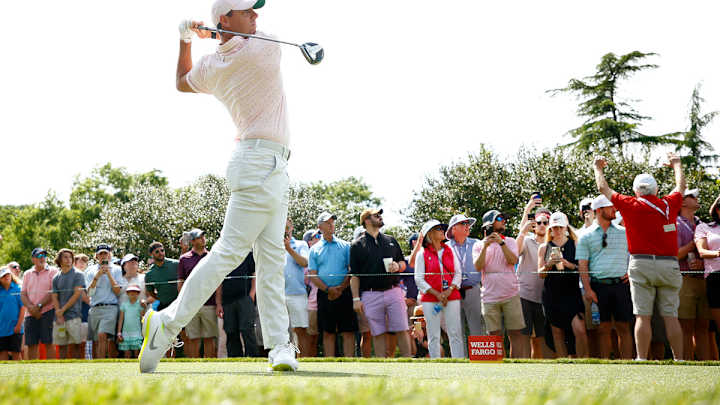Rory McIlroy changes direction, but has he turned corner?

The resurgence of Rory McIlroy after an 18-month winless drought didn’t exactly feature the type of golf one would associate with a man whose ills are completely behind him. Out of the woods? Northern Ireland’s finest spent more time in the pine needles last weekend than Euell Gibbons logged in a busy month, courtesy of numerous errant drives that greatly compromised the value of his prodigious length.
McIlroy clearly had survival in mind as he reached Quail Hollow’s 18th tee late Sunday afternoon with a two-shot lead. He geared down to a 3-wood and hooked it 40 yards left, doing the only thing he absolutely couldn’t do: knock it into the hazard. Although his ball didn’t wind up in the creek, McIlreckless deemed the situation severe enough to take a penalty drop, then slashed his third onto the green and held on to beat Abraham Ancer by one.
Some would refer to McIlroy’s 19th PGA Tour victory as a triumph of perseverance, which is a kind way of saying he didn’t have anything close to his best stuff. His two best shots in the final round came from greenside bunkers. His obsession with distance – a self-admitted preoccupation brought on by the enviable success of chief power monger Bryson DeChambeau – has turned the boxer into a puncher. Nothing that happened in Charlotte could lead you to believe otherwise, nor was there anything perseverant about his performance.
There are times when brilliance is cleverly disguised as resilience, and this was one of them. McIlroy and Tiger Woods are the only players since Seve Ballesteros who could win meaningful tournaments from the right trees. At Quail Hollow, McIlroy beat a quality field largely because of an ultra-tidy short game, plus the simple fact that none of the other big names – DeChambeau, Xander Schauffele, Justin Thomas, et al. – put themselves in a position to threaten on the weekend.
With Keith Mitchell (one Tour victory), Gary Woodland (having a rough 2021) and Ancer (still winless) doing most of the chasing, McIlroy found himself operating with a larger margin of error, so to speak, and he used just about all of it. He is an exquisitely talented player capable of lapping everyone on the grounds when he’s in peak form, a dominance best evidenced by the fact that two of his four major titles came by eight strokes apiece, a feat otherwise achieved only by Woods in the modern era.
You don’t win four majors by the age of 25 unless you’re very special, but you don’t go 7½ years without winning a fifth, either. No player in any era has accomplished so much so soon as did McIlroy, then endured such a pronounced flattening of his career trajectory in what many would consider his competitive prime. Jack Nicklaus went a little more than three years between claiming the 1967 U.S. Open and 1970 British Open. Before he hit the hydrant, Woods endured his longest majorless stretch from June 2002 to April 2005.
Yes, McIlroy has picked up a couple of FedEx Cup crowns since hoisting his last big trophy at the 2014 PGA Championship, but that’s like comparing Pro Bowls to Super Bowls. What’s truly alarming is that he hasn’t come all that close to winning a fifth major in the 24 held since the ’14 PGA. His best chance by far occurred at the 2018 British, when McIlroy overcame a listless start to his final round and grabbed a share of the lead with four holes to play, but Francesco Molinari’s finishing kick left McIlroy in a four-way tie for second, two strokes back.
How does a kid destined for greatness waste such little time demolishing the reverberations of hype, then turn into Lee Westwood? “From my perspective, Rory has gotten away from being Rory,” former CBS analyst Peter Kostis said. “Much the same way Tiger got away from being Tiger for a while, although he had so much talent, he was able to win with two or three different swings. Rory had certain things in his golf swing that fit together beautifully. The gears meshed, but when you change one gearbox, you mess up everything.
“His swing has gotten a little bit more round, less [vertical] than it was, and he needs to go back to his fundamentals. I’m not sure whether Pete Cowen [whom McIlroy began working with in March] is the guy to do that, but we’ll find out soon enough. Golf’s landscape is littered with major champions who, in an attempt to get better, lost who they were. Every one of them had good intentions but failed to get the results they’d gotten before.”
What’s interesting about McIlroy in his career is that he became a prolific winner early despite dealing with a litany of management and equipment-related issues, all of which received considerable media attention. He spent three years (2011-14) in a high-profile relationship with Caroline Wozniacki, one of the world’s best women’s tennis players at the time, and developed a tendency to say things that rubbed a lot of people the wrong way. He dissed the Ryder Cup, skipped a Players Championship and angrily hurled a club into the water on the par-5 eighth at Doral.
Remember the alleged toothache that prompted McIlruckus to walk off PGA National during the second round of the 2013 Honda Classic? This was back when he seemed to change his mind every month as to which tour was his primary circuit. On either side of the Atlantic, young McIlroy was virtually unbeatable five or six times a year.
The phenom turned 32 last week. He’s married, the father of an 8-month-old daughter, wealthier than a shipping magnate, healthier than an aerobics instructor. McIlroy’s life is, relatively speaking, almost commotion-free. His job is to win golf tournaments, notably historic ones, and become the player whom he once was – the player whom he always was supposed to be.
Charlotte was a step in the right direction. Are there long-term ramifications? As Kostis said, we’ll find out soon enough. After all, a little perseverance can take a man a long way
Sign up to receive the Morning Read newsletter, along with Where To Golf Next and The Equipment Insider.
